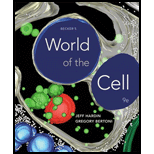
(a)
To determine: What the short-term effect of sudden reduction of carbon dioxide concentration by 1000-fold will be on the levels of 3-phosphoglycerate and ribulose-1, 5-bisphosphate.
Introduction: Chlorella is a single-celled green alga which is usually found in freshwater. It carries out photosynthesis because of the presence of Chlorophyll a and b. It is known to have a very high efficiency of photosynthesis and thus can be used as a source of food.
(b)
To determine: What the short-term effect of restriction of light to green wavelengths (510-550 nm) will be on the levels of 3-phosphoglycerate and ribulose-1,5-bisphosphate.
Introduction: Chlorella is a single-celled green alga which is usually found in freshwater. It carries out photosynthesis because of the presence of Chlorophyll a and b. It is known to have a very high efficiency of photosynthesis and thus can be used as a source of food.
(c)
To determine: What the short-term effect of an addition of an inhibitor oh photosystem II will be on the levels of 3-phosphoglycerate and ribulose-1,5-bisphosphate.
Introduction: Chlorella is a single-celled green alga which is usually found in freshwater. It carries out photosynthesis because of the presence of Chlorophyll a and b. It is known to have a very high efficiency of photosynthesis and thus can be used as a source of food.
(d)
To determine: What the short-term effect of reduction of oxygen concentration from 20% to 1% will be on the levels of 3-phosphoglycerate and ribulose-1, 5-bisphosphate.
Introduction: Chlorella is a single-celled green alga which is usually found in freshwater. It carries out photosynthesis because of the presence of Chlorophyll a and b. It is known to have a very high efficiency of photosynthesis and thus can be used as a source of food.
Want to see the full answer?
Check out a sample textbook solution
Chapter 11 Solutions
Becker's World of the Cell (9th Edition)
- The Sentinel Cell: Nature’s Answer to Cancer?arrow_forwardMolecular Biology Question You are working to characterize a novel protein in mice. Analysis shows that high levels of the primary transcript that codes for this protein are found in tissue from the brain, muscle, liver, and pancreas. However, an antibody that recognizes the C-terminal portion of the protein indicates that the protein is present in brain, muscle, and liver, but not in the pancreas. What is the most likely explanation for this result?arrow_forwardMolecular Biology Explain/discuss how “slow stop” and “quick/fast stop” mutants wereused to identify different protein involved in DNA replication in E. coli.arrow_forward
- Molecular Biology Question A gene that codes for a protein was removed from a eukaryotic cell and inserted into a prokaryotic cell. Although the gene was successfully transcribed and translated, it produced a different protein than it produced in the eukaryotic cell. What is the most likely explanation?arrow_forwardMolecular Biology LIST three characteristics of origins of replicationarrow_forwardMolecular Biology Question Please help. Thank you For E coli DNA polymerase III, give the structure and function of the b-clamp sub-complex. Describe how the structure of this sub-complex is important for it’s function.arrow_forward
- Molecular Biology LIST three characteristics of DNA Polymerasesarrow_forwardMolecular Biology RNA polymerase core enzyme structure contains what subunits? To form holo enzyme, sigma factor is added to core. What is the name of the structure formed? Give the detailed structure of sigma factor and the function of eachdomain. Please help. Thank youarrow_forwardMolecular Biology You have a single bacterial cell whose DNA is labelled with radioactiveC14. After 5 rounds of cell division, how may cells will contain radioactive DNA? Please help. Thank youarrow_forward
- 1. Explain the structure and properties of atoms and chemical bonds (especially how they relate to DNA and proteins). Also add some pictures.arrow_forward1. In the Sentinel Cell DNA integrity is preserved through nanoscopic helicase-coordinated repair, while lipids in the membrane are fortified to resist environmental mutagens. also provide pictures for this question.arrow_forwardExplain the structure and properties of atoms and chemical bonds (especially how they relate to DNA and proteins). Also add some pictures.arrow_forward
 BiochemistryBiochemistryISBN:9781305577206Author:Reginald H. Garrett, Charles M. GrishamPublisher:Cengage Learning
BiochemistryBiochemistryISBN:9781305577206Author:Reginald H. Garrett, Charles M. GrishamPublisher:Cengage Learning BiochemistryBiochemistryISBN:9781305961135Author:Mary K. Campbell, Shawn O. Farrell, Owen M. McDougalPublisher:Cengage Learning
BiochemistryBiochemistryISBN:9781305961135Author:Mary K. Campbell, Shawn O. Farrell, Owen M. McDougalPublisher:Cengage Learning

